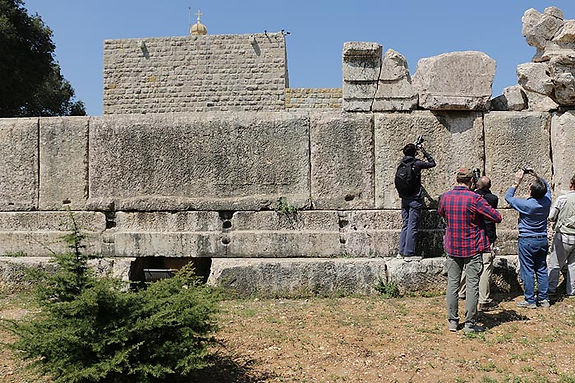

WILL HART

The Real Weight of Histories Mysteries
(The Baalbek & Temple Mount Enigma)
By Will Hart
The trilithon-stones, outlined in red, span across the lower middle of the photo. A man is shown in black.
The foundation stones of the Temple of Jupiter. You can see that different builders added to the original structure over the course of history. It is apparent that the stones get smaller and the quality of stone masonry & craftsmanship gets cruder, which goes against any evolutionary theory, the oldest ought to be the smallest and simplest.
The Trilithon of Baalbek consists of three colossal stones measuring 19 meters long x 4.2 meters high x 3.6 meters wide and weighing about 800 tons each! These stones were hauled about 1 km. from the quarry and then hoisted up and placed at a height of 10 meters. In spite of their immense size, they were precisely joined…so tightly fit together that it is nearly impossible to insert a needle between them
This presents an impossible task --to any ancient (human) builders-- because it would require technology and methods only recently available. To wit, to move a 340-ton stone sculpture from the quarry to art museum in Los Angeles, a distance of 8 miles, a custom-built truck that had 28 wheels and was nearly a block long was employed.
The above stone weighed a bit more than 1/3 the weight of each of the trilithon blocks. That surely puts three !!! on the degree of difficulty posed.
In addition, to lifting and carefully positioning the blocks in their final resting places, a feat that would have required a massive crane. Only in recent years have mobile cranes with an 800-ton capacity been manufactured!
To try to explain how humans without any such heavy machinery could equal the power of that heavy equipment is pure fantasy! (Worse, sheer lunacy!) That is simply an old, worn-out, bad paradigm that historians still cling to nonetheless.
However, identifying the builders is irrelevant. The first problem is establishing the level of technology required to do the job. Who may have had such technology, in prehistoric times, follows after that determination is made.
In fact, the first crane that was rated to lift a load above 350 tons, was custom-built to lift up the Space Shuttle. This fact reveals that it took civilization 5,000 years to develop heavy machinery capable of handling a little more than half the load of a trilithon block!
Historians and archaeologists cannot overlook these points, just because non-academic, independent observers make them. However in fact they do or try to anyway! I have yet to read any academic presentations that bring up the issues raised in this article. Yet I am including the actual history and evolution of technology in it, surely relevant factors.
During the course of that history the problems of lifting very heavy loads was addressed. However, only to a point, which was far below the size of the Baalbek stones. Therefore, to claim that the Romans managed to do -- what could not be accomplished with modern machinery even 50 years ago -- seems ludicrous, even bizarre.
Yet this is the accepted proposal held by the majority of academics in the field. However, I am going to list a number of critical reasons that thesis should be flatly rejected and shredded:
-
The Romans added on many buildings, columns, etc to the Temples at Baalbek. However, the did not build the lower levels that include the trilithon.
-
Roman engineers were put to the test in Egypt when Rome ordered them to cut down and bring a number of obelisks back home. The largest they ever attempted weighed 430 tons. They did not have to quarry and lift it out of a hole. Still, they failed on their first attempts. They did succeed years later, however.
-
That obelisk is the heaviest load the Romans ever manipulated and it was recorded. It was about half the weight of a trilithon block. There is no record of the Romans making any claim about creating and moving the trilithon stones at Baalbek.
-
These blocks are not at all typical of Roman stonemasonry. A survey of existent Roman sites in far flung places reveals that fact. Their style was most often small to medium sized blocks, never cyclopean size, cut and dressed, stones.
-
However, even more telling is the architectural design of the foundation. In fact, it is upside-down, compared to the style used in western architecture for many centuries. Note the largest blocks were placed above the lowest tiers, which contain much smaller blocks.
-
The Romans never used this peculiar, inverted style.
Above, the Baalbek trilithon stones across the 3rd tier, smaller stones oddly below form the foundation. Below, the diagram shows the construction design, which appears irrational to our modern minds.
To modern architects and engineers, the Baalbek foundation is basically inverted, upside-down and even illogical!
Look at the photo again and you will see the massive trilithon stones are sitting on top of much smaller blocks (diagram). This is a matter for hard science to grapple with, ie, independent engineers and physicists, to study and weigh in on.
What level of technology, (heavy machinery etc.) was required to achieve the results we observe at Baalbek? That needs determining by independent researchers. Without a doubt infinitely greater than what ancient humans possessed thousands of years ago!
* * * *
The Temple Mount & Western Wall, Jerusalem
(Deep Enigmas Linked to Baalbek)
Exterior portion of the massive Western Wall
It is not just Baalbek that is an enigma of the highest magnitude. We have another very famous site of great interest to us. Lying about 250 miles due south of Baalbek is the most holy city, Jerusalem.
Most people have no idea that this city goes far, far back into the remote prehistory of the biblical Land of Canaan. When Abram meets the King of Salem, (Melcizedek) after emerging victorious from his battle with the Kings of Sodom & Gomorrah, the encounter takes place just outside of the city’s wall, below the eastern gatel.
In fact, the city was known as Shalem then and before that era also. The people of Canaan had built the city long before Abram came to it, many millenium prior to the arrival of his descendants, (Moses and Joshua), to the Promised Land (Canaan).
Our main interest here, in this specific context, is the Temple Mount and the Western Wall. Here a slice of the deepest, most cryptic side of the history of our planet is finally, partially disclosed.
Within the interior portion of the Western Wall, we find massive blocks of stone.
The largest stone in the Western Wall, 40’+ long, 500+ tons in weight
Upon close inspection, they do not just resemble those we observed at Baalbek, they are identical! We see the same ancient weathering, same notches, same impossible size, yes, one (below) weighs 500+ tons!
It is clear that whoever the builders of Baalbek were, also built this wall. To put a fine point on that assertion, we turn to some other details, As the old saying goes, the truth is in the details. The Baalbek stones bear a unique style and signature. One small feature of their design is a raised relief. Now, a close examination of the blocks in the Western Wall, reveal the exact same design element! Note the recessed fringe that forms the border.
Interior of underground portion of the Western Wall. Close up of the signature style of the unknown Builders, which is not evident in any other megaliths worldwide.
Above, massive wall mostly in ruins at Baalbek.
Now we can see and compare the stonework at Baalbek above to that exhibited in the Western Wall. Only these Builders used these impossibly heavy blocks of stone, not just megaliths, but monstrous blocks no one else could or can handle.
That is one way to separate them from all others. The second is the recessed border, also totally unique. The craftsmanship, style, and huge dimensions puts Baalbek and the Western Wall in a category all their own.
There seems no doubt that whoever built one also constructed the other. It seems that only a handful of researchers have made these connections to date. This is going to rock the traditions of Judaism, Islam and Christianity who go along with the conventional Roman scenario.
I have tracked down several other sites that also have this unique style of stonework. That they are all in a relatively small, confined geographic area -- known as the Holy Land -- is certainly auspicious.
The first additional site is located in the hills of Israel and known as King Nimrod’s Fort. I do not think it a blind coincidence that Nimrod is mentioned in ? in association with building Baalbek! Here, at least with the largest of the stones, we find that inimitable style..
King Nimrod’s Fort, Israel
The next site is located in Lebanon not far from Baalbek. Here we find the obvious signature stonework, used as the foundation for a Church, which sits on top. The stone blocks there are identical to those at Baalbek.









